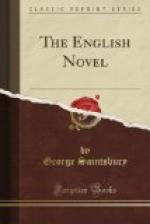That not exactly credit to the Tory party, Dr. John Shebbeare, has had his demerits in other ways excused to some extent on the score of Lydia—whose surname, by the way, was “Fairchild,” not unknown in later days of fiction. Even one who, if critical conscience would in any way permit it, would fain let the Tory dogs have a little the best of it, must, I fear, pronounce Lydia a very poor thing. Shebbeare, who was a journalist, had the journalist faculty of “letting everything go in”—of taking as much as he could from Richardson, Fielding, Smollett, etc., up to date (1755); and of throwing back to Afra for an interesting Indian, Canassatego. The book (like not a few other eighteenth-century novels) has very elaborate chapter headings and very short chapters, so that an immoral person can get up its matter pretty easily. A virtuous one who reads it through will have to look to his virtue for reward. The irony is factitious and forced; the sentiment unappealing; the coarseness quite destitute of Rabelaisian geniality; and the nomenclature may be sampled from “the Countess of Liberal” and “Lord Beef.” I believe Shebbeare was once pilloried for his politics. If it had been for Lydia, I should not have protested.
The next book to be mentioned is an agreeable change. Why Hazlitt compared The Life of John Buncle (1756-1766) to Rabelais is a somewhat idle though perhaps not quite unanswerable question; the importance of the book itself in the history of the English novel, which has sometimes been doubted or passed over, is by no means small. Its author, Thomas Amory (1691?-1788), was growing old when he wrote it and even when he prefaced it with a kind of Introduction, the Memoirs of several Ladies (1755). It is a sort of dream-exaggeration of an autobiography; at first sight, and not at first sight only, the wildest of farragos. The author represents himself as a disinherited son who is devoted, with equal enthusiasm, to matrimony, eating and drinking as much as he can of the best things he can find, discussion of theological problems in a “Christian-deist” or Unitarian sense, “natural philosophy” in the vague eighteenth-century meaning, and rambling—chiefly in the fell district which includes the borders of Lancashire, Yorkshire, Westmoreland, “Bishopric” (Durham), and Cumberland. With this district—which even now, though seamed with roads and railways, does actually contain some of the wildest scenery of the island; which only forty years ago was much wilder; and which in Amory’s time was a howling wilderness in parts—he deals in the characteristic spirit of exaggeration which perhaps, as much as anything else, suggested Rabelais to Hazlitt. From Malham Cove and Hardraw Scar, through the Wild Boar Fell district to the head of Teesdale, you can find at this moment rough and rugged scenery enough, some of which is actually recognisable when “reduced” from Amory’s extravagance. But that extravagance




